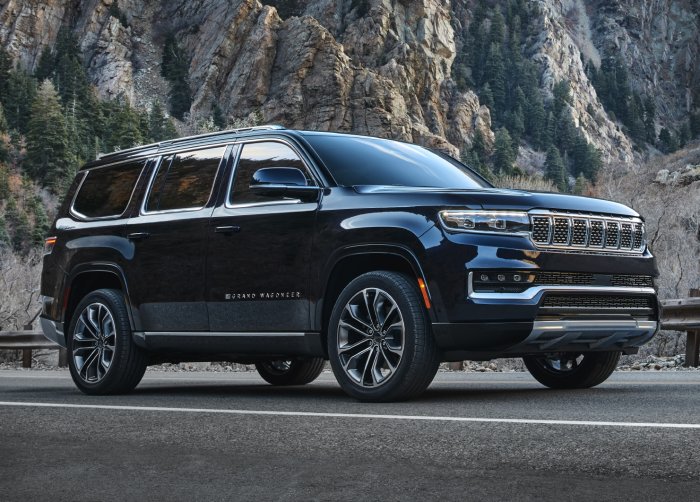Earlier today, we brought you all of the key information on the new 2022 Jeep Wagoneer and Grand Wagoneer. While the two vehicles are based on the same basic body and chassis, there are key differences inside, outside and under the hood which you can read about by clicking here. With there being so much information about the two new Jeeps, we didn’t include measurements or the measurements of the key competitors, but since our introduction piece went live, many people have asked how the Wagoneer lineup compares in exterior dimensions to other large body-on-frame SUVs.
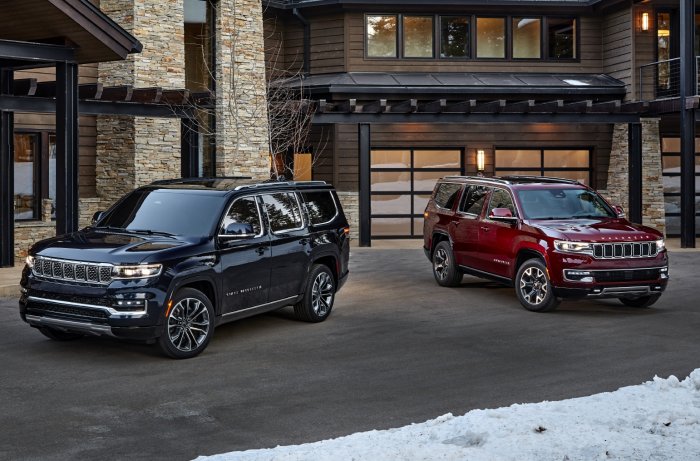
Below, we break down the key exterior measurements of the Wagoneer, Grand Wagoneer and their top competitors in the large SUV segments – the Chevrolet Suburban and the Cadillac Escalade ESV. It should be noted that the Chevrolet Tahoe and Cadillac Escalade (non-ESV) are in the same class, but both of those vehicles are markedly smaller than the Wagoneer or Grand Wagoneer. Since the Jeeps are a better comparison for the larger versions of the Chevy and Caddy SUVs, we have focused on the Suburban and Escalade ESV.
Wagoneer and Grand Wagoneer Exterior Dimensions
The 2022 Jeep Wagoneer and Grand Wagoneer are both 214.7 inches long with a 123-inch wheelbase. The body is 83.6 inches wide and with the mirrors, the overall width is 94 inches. The front track width is 68.5 inches and the rear track width is 68.3 inches. The new Jeeps sit 75.6 inches tall at the top of the roof rails or 77.3 inches tall at the tip of the antenna.
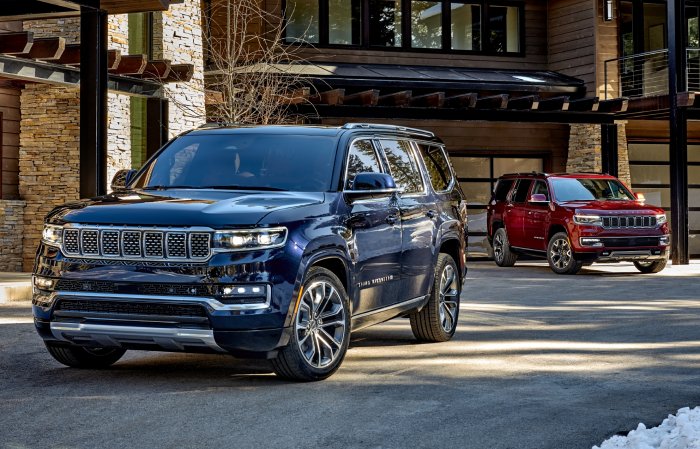
In terms of key off-road metrics, the Jeep Wagoneer and Grand Wagoneer are offered with a standard coil-spring suspension setup or an active air suspension system. That leads to a variety of undercarriage measurements, so the brand only shared the clearance numbers for the standard suspension or the air suspension in its highest-riding setting. With a 275/55/20 tire and the 5.7-liter engine, the Wagoneer has 8.3 inches of ground clearance with the standard suspension and 10 inches with the air suspension in the highest setting. With the standard suspension setup, the approach angle is 21.5 degrees, the breakover angle is 18.5 degrees and the departure angle is 21.1 degrees. With the air suspension, the approach angle climbs to 25 degrees, breakover angle rises to 22 degrees and the departure angle jumps to 24 degrees.

Finally, the Wagoneer in rear-drive form ranges in curb weight from 5,960 pounds to 6,000 pounds, depending on the trim level, while the four-wheel-drive Wagoneer weighs 6,190 in Series II form while the Series III 4×4 models weigh 6,230. The Grand Wagoneer ranges from 6,340 to 6,420 pounds with the 392 Hemi and the standard four-wheel-drive system. Wagoneer will tow up to 10,000 pounds while the Grand Wagoneer will tow 9,850 pounds.
Wagoneer Compared to Chevy Suburban
The Chevrolet Suburban has an overall length of 225.7 inches and a wheelbase of 134.1 inches, so it is about 11 inches longer than the Jeep Wagoneer overall, most of which is in the wheelbase. The Chevy is 75.7 inches, which is nearly identical to the Jeep, but with a body width of 81.1 inches, the Suburban is narrower than the Wagoneer. The two vehicles have identical front and rear track width.

The Chevrolet Suburban Z71 is available with coil springs or air suspension. The coil springs offer 8 inches of ground clearance while the air suspension offers 10 inches, giving the Wagoneer an advantage with the stock suspension. The Chevrolet information lists 6 different sets of off-road measurements with different suspensions, trim levels and mode settings. Suburban approach angle ranges from 24.5 degrees with the base suspension to 34.5 degrees for a Z71 model with air suspension in the tallest setting, giving the Chevy a head-to-head advantage in that category. Breakover angle ranges from 20 to 22 degrees, so the Wagoneer is in the same general range. In terms of departure angle, the Suburban ranges from 16 to 19 degrees, so the Jeep has a big advantage out back.

Chevrolet Suburban curb weights start around 5,616 pounds for the rear-drive models, topping out just over 6,000 pounds for a V8 4×4 model. In other words, the Suburban is generally lighter than the new Jeep Wagoneer, but the Suburban towing tops out at 8,300 pounds, so the Jeep has a big advantage in that area.

The Suburban is offered with three engines – a 5.3L V8, a 6.2L V8 and a 3.0L turbo diesel V6. The base 5.3 offers 355hp and 383 lb-ft of torque and the optional V8 offers 420 horsepower and 460 lb-ft of torque. The Wagoneer’s standard 5.7L Hemi eTorque offers 392 horsepower and 404 lb-ft of torque, so it is quite a bit more power than the 5.3, but short on power compared to the 6.2. Should the standard 6.4L Hemi from the Grand Wagoneer ever be offered in the Wagoneer, it would have a big power advantage over the Chevy, but for now, the Suburban’s optional V8 has the power lead.
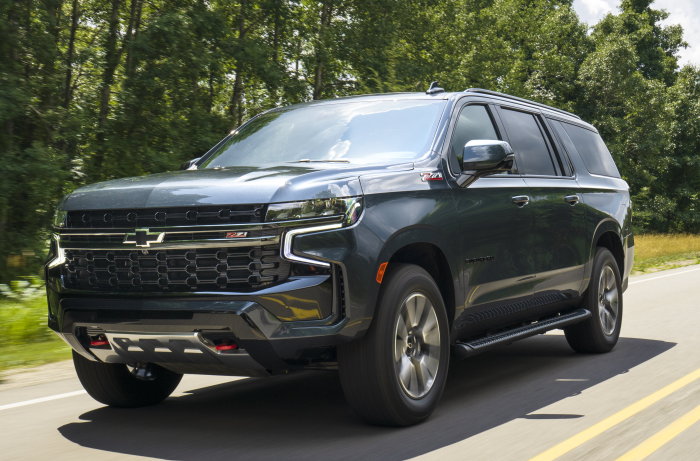
In short, the Chevrolet Suburban is longer and lighter than the new Jeep Wagoneer, with an advantage in approach angle while the Wagoneer has a slightly wider body, an advantage in departure angle and a big advantage in towing capacity. When comparing standard engines, the Jeep has a big advantage, but the Chevy’s optional V8 offers more horsepower and torque than the sole Wagoneer engine.

Grand Wagoneer Compared to the Cadillac Escalade
The new Cadillac Escalade ESV has an overall length of 226.9 inches and a wheelbase of 134.1 inches, making it 11 inches longer than the Jeep between the wheels and more than 12 inches longer overall. At 81.1 inches wide, the Cadillac is narrower than the Grand Wagoneer while the height of 76.4 inches makes the Escalade a touch taller, too. The Cadillac and Jeep have the same track widths.
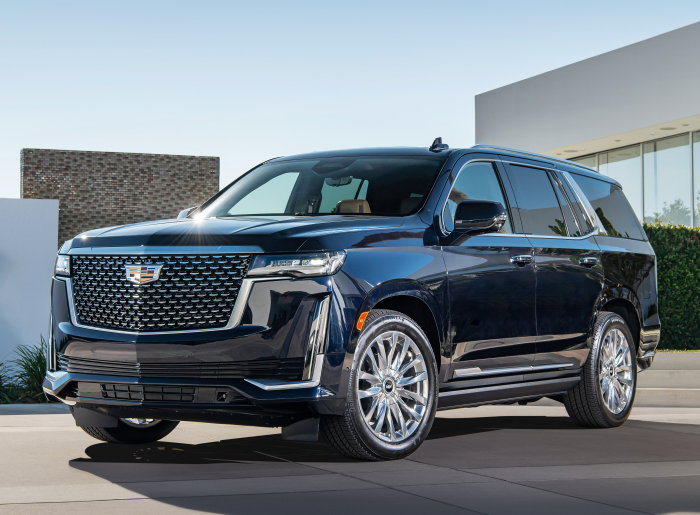
The off-road oriented measurements for the 2022 Jeep Grand Wagoneer are the same as the numbers for the Wagoneer, but Cadillac doesn’t list these types of numbers for the Escalade. No one takes an Escalade off-road and General Motors knows that, so approach, breakover and departure angles aren’t included in the spec sheet. Really, we don’t expect that anyone is going to spend much time off-roading in a new Grand Wagoneer, either.
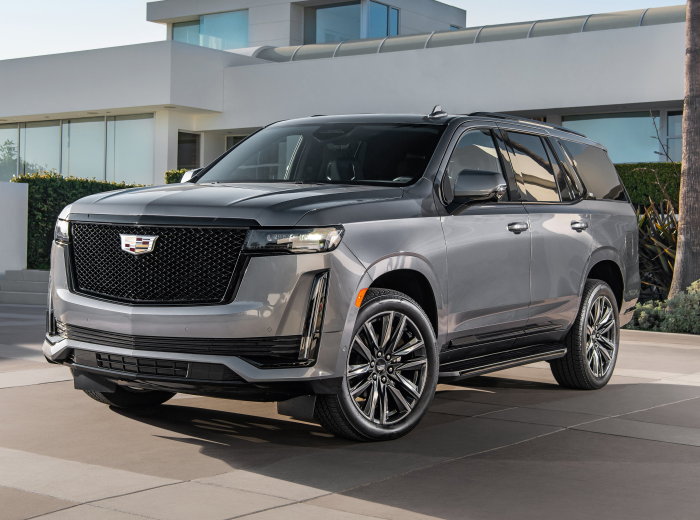
The Cadillac is available with either a 6.2L V8 with 420 horsepower and 460 lb-ft of torque or a turbocharged 3.0L V6 with 277 horsepower and 460 lb-ft of torque. The Grand Wagoneer’s standard 392-cubic inch Hemi offers a big advantage in power with 471 horsepower and with the Caddy topping out at 8,100 pounds when it comes to towing, the Grand Wagoneer has a big advantage at 9,850 pounds.

So, the Cadillac Escalade it longer overall, has a longer wheelbase, is narrower and sits a little higher than the Grand Wagoneer, but the Jeep has an obvious advantage in off-roading, power and towing capacity.
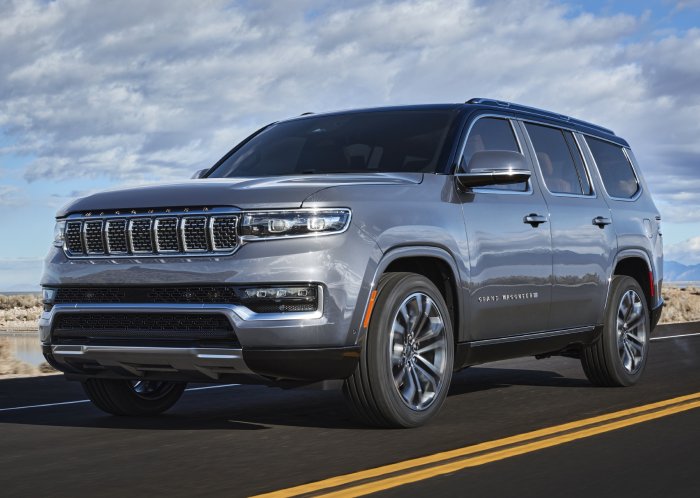
Discover more from Stellpower - that Mopar news site
Subscribe to get the latest posts sent to your email.
